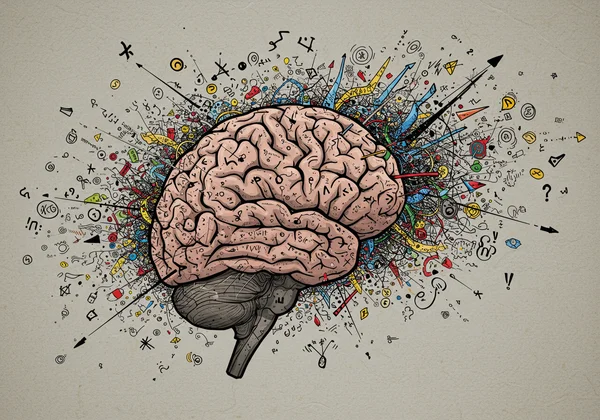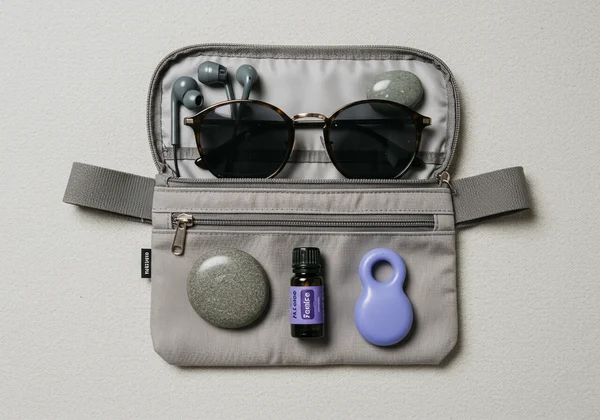Sensory Overload in Adults: Practical Tips & Understanding Your AQ Test Results
Do you ever feel like the world is turned up to maximum volume? Bright lights feel like spotlights, distant conversations blur into a wall of noise, and the tag on your shirt feels like sandpaper. If this sounds familiar, you might be experiencing sensory overload. You're not alone in feeling this way. This article offers practical strategies and valuable insights to help you navigate these challenging moments, empowering you to navigate your world with greater calm and control. Do you often feel overwhelmed by your senses? We will explore what sensory overload is and provide seven practical, actionable strategies to help you manage these challenging moments. Understanding your sensory needs is a powerful first step, and tools like an online AQ test can offer valuable insights.
Understanding Adult Sensory Overload & Its Triggers
Before we can manage sensory overload, it’s essential to understand what it is and what might be causing it. This isn't about being "too sensitive"; it's about how your brain processes the constant stream of information from your environment. For many adults, identifying these triggers is the beginning of a journey toward greater comfort and self-awareness. Recognizing patterns in your responses can transform feelings of chaos into opportunities for proactive self-care and is a key part of understanding your unique traits.
What is Sensory Overload? A Definition for Adults
Imagine your brain is an airport control tower. On a typical day, planes (sensory information) land and take off smoothly. During sensory overload, it’s as if a hundred planes try to land at once without clearance. The system gets jammed, leading to a shutdown or a crisis response. For adults, this can manifest as sudden irritability, an intense need to escape, difficulty concentrating, anxiety, or even physical discomfort. It’s a temporary overwhelm of your nervous system’s capacity to process incoming sensory perception, making it incredibly difficult to function.

Common Sensory Triggers in Daily Life
Triggers are highly personal, but many adults find their sensory systems are most challenged by common environmental factors. Recognizing your specific sensory triggers is crucial for developing effective coping strategies. Here are some of the most frequent culprits:
- Auditory: Loud, sudden noises (sirens, alarms), overlapping conversations (in a restaurant or office), background music, or even persistent, low-level sounds like a humming refrigerator.
- Visual: Bright or fluorescent lighting, flashing screens, cluttered spaces, busy patterns, or fast-moving crowds.
- Tactile: Uncomfortable clothing textures, unexpected light touches, temperature changes, or the feeling of certain foods.
- Olfactory (Smell): Strong perfumes, cleaning products, cooking odors, or polluted air.
- Vestibular & Proprioceptive: Feeling off-balance, motion sickness, or being in a jostling crowd can overwhelm the senses that govern balance and body awareness.
Proactive Strategies: Preventing Sensory Overload
The most powerful way to handle sensory overload is to prevent it from happening in the first place. These proactive strategies are about creating a life that respects your sensory limits, allowing you to conserve your energy for the things that matter most. Learning to manage sensory overload is a skill that can be developed over time.
Tip 1: Curate Your Environment: Sound, Light & Space
Your home should be your sanctuary. Make conscious choices to create a sensory-friendly space. This could mean installing dimmer switches to control lighting, using blackout curtains, or choosing appliances that operate quietly. Decluttering your living and workspaces can significantly reduce visual stress. Noise-canceling headphones are an invaluable tool, allowing you to create a pocket of peace wherever you are. By controlling your immediate environment, you establish a baseline of calm that makes navigating the outside world easier.
Tip 2: Build a Sensory Toolkit for On-the-Go
You can't always control the world, but you can control what you bring with you. A sensory toolkit is a small bag of items that can help you regulate in a challenging environment. This is your personal first-aid kit for sensory distress. Contents might include:
- High-quality earplugs or earbuds
- Sunglasses or a wide-brimmed hat
- A small, smooth stone or a fidget toy to hold
- A vial of a calming essential oil like lavender
- A chewy or crunchy snack
Having this kit ready means you are always prepared to manage unexpected sensory challenges.

Tip 3: Time Management: Pacing & Sensory Breaks
Many of us try to push through our days, ignoring our body's signals until it's too late. Practice proactive self-regulation by building sensory breaks into your schedule. If you know you have a stimulating event like a party or a busy shopping trip, schedule quiet time before and after to decompress. Avoid stacking multiple demanding activities back-to-back. Think of your sensory capacity like a battery; every intense experience drains it, and only rest and quiet can recharge it. Taking a five-minute break in a quiet room can be more restorative than an hour spent fighting through the noise.
In-the-Moment & Recovery Tips for Sensory Overload
Even with the best planning, overload can still happen. When it does, knowing how to respond in the moment—and how to care for yourself afterward—is vital. These tips focus on immediate relief and long-term recovery. These coping strategies are essential for building resilience.
Tip 4: Grounding Techniques for Immediate Relief
When you feel the wave of overload building, grounding techniques can bring you back to the present moment and calm your nervous system. The goal is to shift your focus from the overwhelming external stimuli to a simple, internal sensation. Try the 5-4-3-2-1 method:
- 5: Acknowledge five things you can see around you.
- 4: Acknowledge four things you can feel.
- 3: Acknowledge three things you can hear.
- 2: Acknowledge two things you can smell.
- 1: Acknowledge one thing you can taste.
This simple exercise redirects your brain and can stop an overload episode from escalating.

Tip 5: Prioritizing Rest and Recovery
After an episode of sensory overload, your brain and body need time to recover. Pushing yourself to "get back to normal" too quickly can lead to a cycle of burnout. Recovery is not a luxury; it's a necessity. Find a quiet, dark space where you can lie down. Limit screen time and social interaction. Engage in a calming activity like listening to gentle music, wrapping yourself in a weighted blanket, or simply focusing on your breath. Honoring your need for rest is a profound act of self-care.
Tip 6: Communicating Your Needs Effectively
One of the hardest parts of managing sensory issues is explaining them to others. You have a right to advocate for your needs. Practice simple, clear statements you can use in social or work situations. For instance:
- "I need to step outside for a few minutes of quiet."
- "Would it be possible to turn down the music a little?"
- "I work best without background noise, so I'll be putting on my headphones."
Communicating your needs helps others understand and support you, fostering a more inclusive environment that respects neurodiversity.
Beyond Management: Understanding Your Unique Sensory Profile
The seventh and most transformative tip is to move beyond just managing symptoms and toward a deep understanding of your unique sensory world. Why are you sensitive to certain stimuli? What does it say about how your brain is wired? This journey of self-discovery is where true empowerment lies. By understanding your foundational traits, you can build a life that aligns with your needs.
When to Seek Professional Guidance
While these tips can provide significant relief, they are not a substitute for professional medical advice. If sensory issues are causing significant distress or impacting your ability to function, please consult a healthcare professional, such as a doctor or an occupational therapist. They can help rule out other conditions and provide tailored therapeutic strategies. Remember, seeking help is a sign of strength.
Self-Discovery with the AQ Test: A Path to Understanding
Heightened sensory sensitivity is a very common trait for adults on the autism spectrum. For many self-explorers, understanding this connection is a lightbulb moment. If you're curious about your own traits, a great place to start is to take the free test on our website. The Autism Spectrum Quotient (AQ) test is a scientifically validated screening tool designed to measure autistic traits in adults.
Our free AQ test goes beyond a simple number. After completing the 50-question assessment, you have the option to receive a personalized, AI-generated report. This report provides deep insights into your unique sensory profile, potential strengths, and challenges, offering actionable advice tailored to you. It's a confidential and accessible way to start understanding the "why" behind your experiences. Are you ready to explore your profile?

Empowering Your Journey: Living Well with Sensory Sensitivity
Living with sensory sensitivity doesn't have to mean living in a state of constant overwhelm. By understanding your unique triggers, implementing proactive strategies, and knowing how to respond in the moment, you can regain a sense of control and peace. Your journey toward self-knowledge starts now – take the next step in understanding yourself and living well with sensory sensitivity. Discover your AQ score and unlock deeper insights into what makes you, you.
Frequently Asked Questions About Sensory Overload & AQ Test
What does a high AQ test score mean?
A high score on the AQ test suggests you have a higher number of traits commonly associated with autism. It is not a measure of "severity" and is neither good nor bad. It simply offers a data point for self-reflection and can help you understand why you might experience things like intense sensory sensitivity, strong interests, or unique social preferences. You can understand your results better with our AI-powered report.
Is the AQ test a diagnosis for autism?
No, absolutely not. This is very important. The AQ test is a screening tool, not a diagnostic instrument. It can indicate that you have autistic traits, but it cannot provide a clinical diagnosis of Autism Spectrum Condition. A formal diagnosis must be made by a qualified healthcare professional, such as a psychiatrist or psychologist, through a comprehensive assessment. You should use the results as a starting point for self-exploration or a conversation with a professional.
What should I do after getting my AQ score?
After receiving your score, we recommend exploring the personalized AI report. It translates your score into meaningful insights about your life. Use this information for self-reflection. It may help you identify and celebrate your strengths or develop new strategies for your challenges. If your score is high and you feel it resonates, you might consider speaking with a therapist or doctor about your results. You can always start by taking our online assessment again if you want to reconsider your answers.
Can sensory overload be a sign of ADHD?
Yes, sensory sensitivities can be a feature of both autism and ADHD, though the underlying reasons may differ. In ADHD, sensory overwhelm can be linked to difficulties with attention regulation and filtering out irrelevant stimuli. In autism, it's often more related to the fundamental way the brain processes sensory input. There is significant overlap between the two conditions, and it is possible to have both. A comprehensive evaluation from a professional is the best way to understand your specific neurotype.